Geothermal Energy Research Team
Proper Utilization of Geothermal Energy
Overview
Abundant geothermal energy exists in Japan, a country rich in volcanoes. Geothermal energy, a stable renewable source unaffected by weather, is expected to play a role in providing baseload power.
Research Target
The team is conducting research and development on the use of geothermal energy on a suitable scale and in a proper style according to underground conditions and social situations with the following catchphrase: “Proper use of geothermal energy”.
In the short term, the team aims to make direct contributions to, and increase the amount of sustainable power generation. They will do this by developing a monitoring system for the coexistence of hot springs and geothermal power generation and performing advanced monitoring of changes in the reservoirs.
Furthermore, in the long term, the team aims to make geothermal energy available on a large scale as a base-load power source by developing innovative power generation technologies. This will be achieved through the use of supercritical geothermal resources originating from the subduction zone. They will also develop methods for using geothermal energy in society.
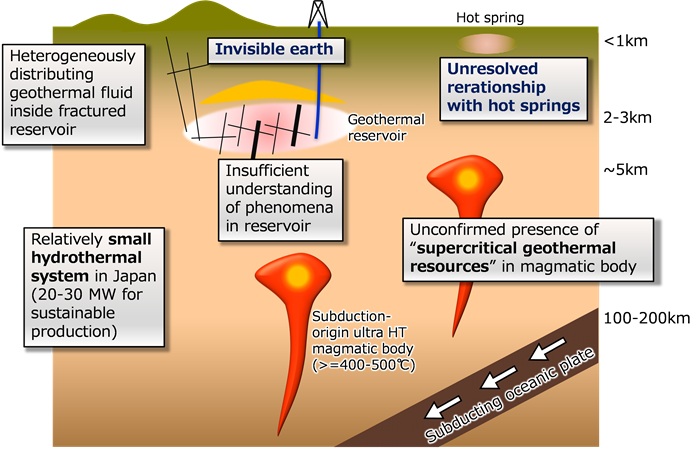
Research Outline
Research for utilizing supercritical geothermal resources
By utilizing high-temperature, high-pressure supercritical geothermal fluids originating from subduction zones for power generation, the total geothermal power generation capacity in Japan may increase dramatically.
The team has conducted detailed modeling and resource assessments of supercritical geothermal systems in promising regions, and proposed specifications and procedures for survey wells. Currently, we are conducting additional reviews of existing surveys in multiple regions and re-evaluating them.
This will facilitate a smooth transition to the experimental drilling phase in the near future.

Research on the evaluation of supercritical geothermal resources
We are conducting research to evaluate the amount of supercritical geothermal resources that can be developed and improve the accuracy of such estimates through surface surveys, literature surveys, numerical calculations, and other methods.
To this end, we are advancing physical exploration technologies that utilize seismic and electromagnetic waves, conducting indoor experiments to measure rock properties and understand mechanical behavior, and developing simulators for hydrothermal flow and other phenomena.
Structural imaging of supercritical geothermal systems and development of a method for identifying promising development areas
Previous studies have indicated the high possibility of “supercritical geothermal reservoirs” However, the distribution and migration pathways of the magma and magmatic fluids, which are the origin of supercritical geothermal resources, have not been sufficiently visualized.
This study aims to visualize the entire supercritical geothermal system using resistivity surveys to validate the conceptual framework with real-world data and identify the conditions necessary for the existence of the reservoir.
Additionally, based on these findings, this study seeks to develop a method for identifying promising areas within regions spanning tens to hundreds of kilometers.
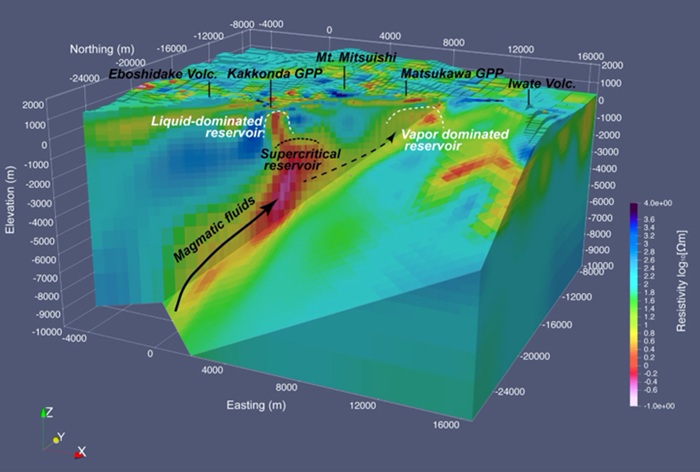
Research on Advanced Evaluation of Geothermal Potential
We collected and database-ized geothermal-related data previously surveyed by AIST and other institutions to be easy to use for AI development.
We developed a method to identify promising exploration sites using AI techniques based on multiple datasets.
Currently, we are developing an AI model capable of predicting the geothermal development potential at a higher resolution. This aims to reduce the uncertainties and risks associated with geothermal development by enhancing the accuracy of potential evaluations.
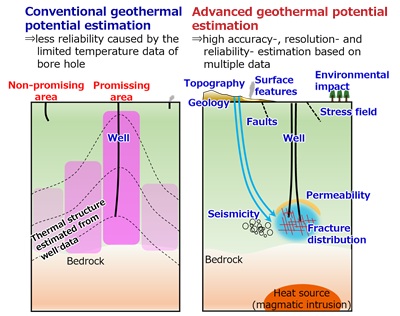
Activities and Achievements
Resource assessment of supercritical geothermal power generation
Based on the results of resistivity surveys, microseismic surveys, seismic wave reflection surveys, and literature, the conceptual geothermal system, which indicated a supercritical geothermal reservoir approximately 3 km below the surface, was modeled in the Kakkonda area of Iwate prefecture.
The results of simulations using this supercritical geothermal reservoir for power generation showed that 100 MW of power could be generated for over 30 years.
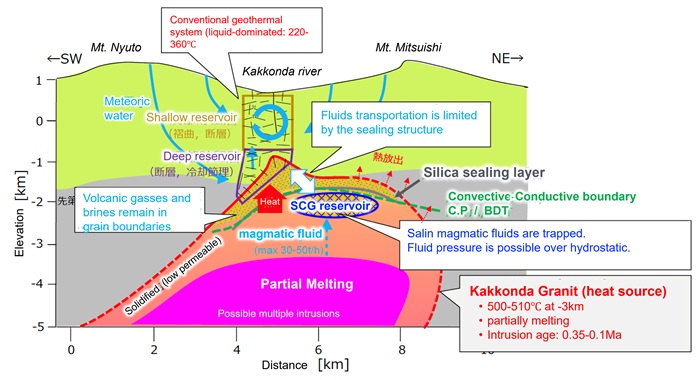
Advanced microseismic monitoring of geothermal reservoirs
High-accuracy hypocenter determination in geothermal fields has been successfully achieved through advanced microseismic analyses.
Fluid flow paths and reservoir structures have been illuminated by analyses of scattering and reflected seismic waves and microtremors, in addition to hypocenter determinations.

Development of simulators of artificial reservoir construction
Based on laboratory experiments on rock mechanics and reservoir engineering, simulators of the construction and production of Enhanced Geothermal System (EGS)-type reservoirs have been developed.
Development of AI-IoT monitoring system of hot-springs
To discuss the scientific relationship between geothermal generation and hot springs, we developed an automatic remote monitoring system for hot spring water quality (temperature, flow rate, electrical conductivity, etc.).
Additionally, we developed AI-based software to detect significant signals and remove noise from the time-series data.
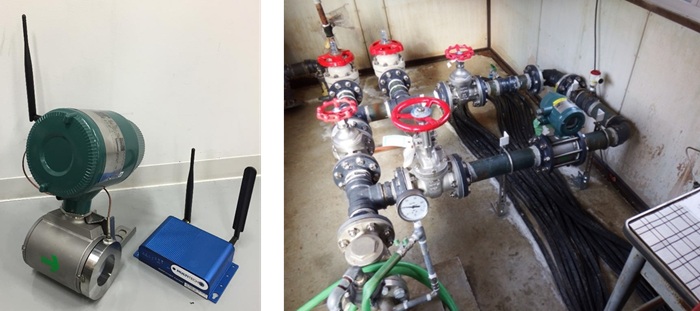
Seeds supporting program from local industry
The team supported the commercialization of technological seeds of local industries under the “Supporting Program of Seeds of Stricken Area” scheme of the FREA. The performance of downhole tools for geothermal wells, a simulator of geothermal reservoirs, a binary power generation system for hot springs, and a hydrogen generation system for hot springs improved throughout this project, and their commercialization is expected in the near future.
Main Research Facilities
Experimental facility for shear slip of a fracture
This facility enables the simulation of various mechanical phenomena in geothermal reservoirs under high temperatures and pressures.
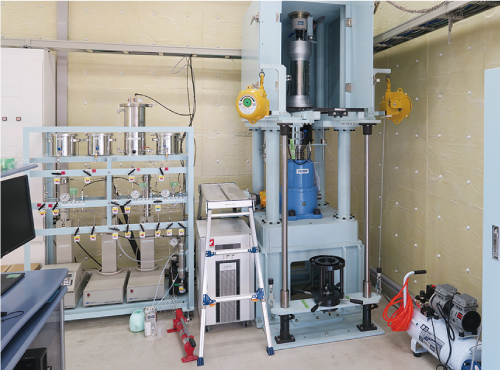
Experimental facility for simulating high-temperature and high-pressure geothermal wells
This facility is capable of simulating 350°C, 60 MPa borehole conditions.

Team Member
| Title | Name |
|---|---|
| Leader, Team | YAMAYA Yusuke |
| Senior Researcher | ISHIBASHI Takuya |
| Senior Researcher | WATANABE Norihiro |
| Senior Researcher | OKAMOTO Kyosuke |
| Senior Researcher | SUZUKI Yota |
| Researcher | MATSUNAGA Yasuo |
| Researcher | SUZUKI Takeshi |
| Attached to Research Team | SAISHU Hanae |
